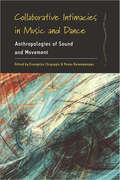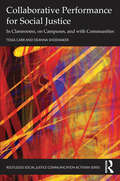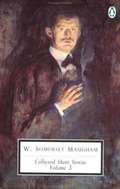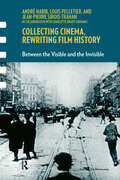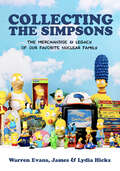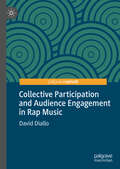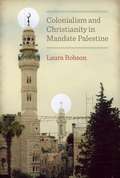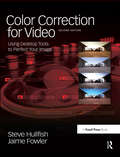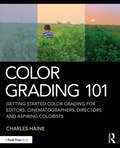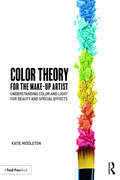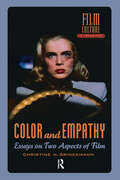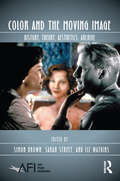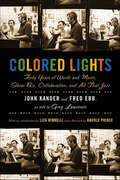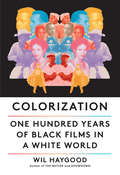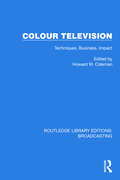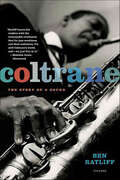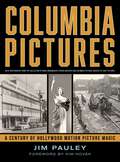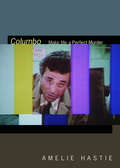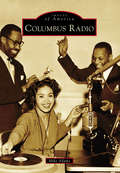- Table View
- List View
Collaborative Intimacies in Music and Dance: Anthropologies of Sound and Movement (Dance and Performance Studies #10)
by Evangelos Chrysagis Panas KarampampasAcross spatial, bodily, and ethical domains, music and dance both emerge from and give rise to intimate collaboration. This theoretically rich collection takes an ethnographic approach to understanding the collective dimension of sound and movement in everyday life, drawing on genres and practices in contexts as diverse as Japanese shakuhachi playing, Peruvian huayno, and the Greek goth scene. Highlighting the sheer physicality of the ethnographic encounter, as well as the forms of sociality that gradually emerge between self and other, each contribution demonstrates how dance and music open up pathways and give shape to life trajectories that are neither predetermined nor teleological, but generative.
Collaborative Performance for Social Justice: In Classrooms, on Campuses, and with Communities (Routledge Social Justice Communication Activism Series)
by Tessa Carr Deanna ShoemakerThis engaging book offers a broad spectrum of collaborative and accessible performance-based practices that promote social justice within college classrooms, rehearsal spaces, campus stages and local communities.Performance is an inherently collective and embodied endeavor. As a form of communication activism, performance also serves as a powerful mode of teaching and learning that demands equitable relationships and mutually established group norms that offer all a seat at the table. Informed by intersectional feminist and antiracist theories, the authors present collaborative performance case studies, ranging from interventions into local histories of oppression to creative protests of campus and cultural practices, to staged interruptions of social discourses and representational systems that perpetuate structural inequities. Illustrating the multiple possibilities of performance, the book offers adaptable tools, evocative stories, and vivid examples from diverse bodies of work. This engaged scholarship is committed to honoring multiple forms of knowledge, acknowledging and building the capacities of individuals and organizations, identifying and developing more spaces for critical dialogue, and envisioning and performing a more socially just world.This book is essential reading for scholars and practitioners of communication, theater, performance studies, arts-based education, and social justice activism.
Collaborative Screenwriting and Story Development: A Global Guide for Writers, Story Teams, and Creative Executives
by Marc HandlerThis is a comprehensive guide to teach writing and story development from a collaborative global perspective. This book teaches writers how to take full advantage of emerging opportunities, both locally and globally. With an increasing number of international co-productions and many screenwriters now working collaboratively in writers rooms and development groups, author Marc Handler explains how to work cooperatively with others to break stories, plan seasons, create characters, and build series. To succeed, readers will learn how to give and receive feedback effectively, adapt to the style and constraints of executives and brands, and contribute to the team building process, all within an increasingly global media industry that is in constant flux. This book will help readers develop a global perspective, ensuring that they are prepared for new opportunities as they arise. Marc Handler provides cultural insight and understanding as he describes the fundamentals as well as advanced story skills. This book is essential reading for students taking classes such as Screenwriting Fundamentals, Writing for Film and TV, Introduction to Television Writing, and Advanced Screenwriting, as well as aspiring and early career screenwriters, showrunners, producers, and creative executives.
Collaborative Theatre: Le Theatre du Soleil
by David Williams Eric PrenowitzOver the past thirty years Ariane Mnouchkine's 'Théâtre du Soleil' has become one of the most celebrated companies in Europe, and Mnouchkine one of its best-known directors. Collaborative Theatre is the first in-depth sourcebook in English on 'Théâtre du Soleil', providing English readers with first-hand accounts of the development of its collectivist practices and ideals.Collaborative Theatre presents critical and historical essays by theatre scholars from around the world as well as the writings of and interviews with members of le Théâtre du Soleil, past and present. Projects discussed include: 1789, L'Age d'Or, Richard II, L'Indiade and Les Atriades.
Collected Essays (Penguin Classics)
by Arthur Miller Susan C. AbbotsonThe collected essays of the "moral voice of [the] American stage" (The New York Times) in a Penguin Classics Deluxe Edition Arthur Miller was not only one of America's most important twentieth-century playwrights, but he was also one of its most influential literary, cultural, and intellectual voices. Throughout his career, he consistently remained one of the country's leading public intellectuals, advocating tirelessly for social justice, global democracy, and the arts. Theater scholar Susan C. W. Abbotson introduces this volume as a selection of Miller's finest essays, organized in three thematic parts: essays on the theater, essays on specific plays like Death of a Salesman and The Crucible, and sociopolitical essays on topics spanning from the Depression to the twenty-first century. Written with playful wit, clear-eyed intellect, and above all, human dignity, these essays offer unmatched insight into the work of Arthur Miller and the turbulent times through which he guided his country. For more than seventy years, Penguin has been the leading publisher of classic literature in the English-speaking world. With more than 1,700 titles, Penguin Classics represents a global bookshelf of the best works throughout history and across genres and disciplines. Readers trust the series to provide authoritative texts enhanced by introductions and notes by distinguished scholars and contemporary authors, as well as up-to-date translations by award-winning translators.From the Trade Paperback edition.
Collecting Cinema, Rewriting Film History: Between the Visible and the Invisible (Framing Film)
by Louis Pelletier André Habib Jean-Pierre Sirois-Trahan Charlotte Brady-SavignacThe writing of cinema history would not be possible without the contribution of collectors. Whether through their pioneering excavation work or their passionate defence of forgotten productions and artifacts, collectors have had a lasting influence on both the field and the methods of moving image history. Proceeding from a renewed dialogue between international film scholars, collectors, filmmakers, curators, and archivists, this book aims to reveal the extent to which collectors and collections have contributed to both the history and the epistemology of moving images. It showcases specific studies of collecting practices, as well as in-depth interviews with collectors and artists bringing to light the innumerable articulations between collecting cinema and the rewriting of film history.
Collecting The Simpsons: The Merchandise & Legacy of Our Favorite Nuclear Family
by James Hicks Warren Evnas Lydia HicksThe Simpsons Merchandise Guide for all Simpsons Lovers “What are the two things every Simpsons’ collector needs? This book and shelves! “ ─Stephanie Gillis, Writer on The Simpsons#1 Best Seller in TV History & CriticismThis quirky book unleashes the entire story of all Simpsons merchandise, spanning decades. Lydia and James Hicks, authors of the bestselling The Simpsons Secret, partner with Warren Evans, the Bart of Darkness, to detail a massive collection of rare Simpsons memorabilia.Jump right into 90s nostalgia! Simpsons lovers everywhere, explore the explosion of Simpsons merchandise and products right in the comfort of your own home. From action figures, video games, comics, lunch boxes, and yes, even cookie jars, this book is a collector's paradise full of insightful information.The perfect collector’s item to have! This full-color guide features high quality photos of Simpsons-inspired products and is the perfect gift for Simpsons lovers as well as fans of Friends, Family Guy, and other classics!Inside:Read for fun: all of the words of Warren Evans, a note-worthy expert on The Simpsons familyFind full-colored photographs of Simpsons merchandise and collector items from the beginning of The Simpsons dynastyIf you're looking for one of the best books for TV nerds who like The Big Bang Theory, Welcome to Dunder Mifflin, or The Simpsons Secret, then Collecting the Simpsons belongs right on your bookshelf!
Collective Participation and Audience Engagement in Rap Music (Pop Music, Culture and Identity)
by David DialloWhy do rap MCs present their studio recorded lyrics as “live and direct”? Why do they so insistently define abilities or actions, theirs or someone else’s, against a pre-existing signifier? This book examines the compositional practice of rap lyricists and offers compelling answers to these questions. Through a 40 year-span analysis of the music, it argues that whether through the privileging of chanted call-and-response phrases or through rhetorical strategies meant to assist in getting one’s listening audience open, the focus of the first rap MCs on community building and successful performer-audience cooperation has remained prevalent on rap records with lyrics and production techniques encouraging the listener to become physically and emotionally involved in recorded performances. Relating rap’s rhetorical strategy of posing inferences through intertextuality to early call-and-response routines and crowd-controlling techniques, this study emphasizes how the dynamic and collective elements from the stage performances and battles of the formative years of rap have remained relevant in the creative process behind this music. It contends that the customary use of identifiable references and similes by rap lyricists works as a fluid interchange designed to keep the listener involved in the performance. Like call-and-response in live performances, it involves a dynamic form of communication and places MCs in a position where they activate the shared knowledge of their audience, making sure that they “know what they mean,” thus transforming their mediated lyrics into a collective and engaging performance.
Collective Trauma and the Psychology of Secrets in Transnational Film (Routledge Advances in Film Studies)
by Deborah Lynn PorterCollective Trauma and the Psychology of Secrets in Transnational Film advances a methodological line of inquiry based on a fresh insight into the ways in which cinematic meaning is generated and can be ascertained. Premised on a critical reading strategy informed by a metapsychology of secrets, the book features analyses of internationally acclaimed films—Guillermo del Torro’s Pan’s Labyrinth, Andrey Zvyagintsev’s The Return, Jee-woon Kim’s A Tale of Two Sisters, and Alejandro Amenábar’s The Others. It demonstrates how a rethinking of the figure of the secret in national film yields a new vantage point for examining heretofore unrecognized connections between collective historical experience, cinematic production and a transnational aesthetic of concealment and hiding.
Colonialism and Christianity in Mandate Palestine
by Laura RobsonDrawing on a rich base of British archival materials, Arabic periodicals, and secondary sources, Colonialism and Christianity in Mandate Palestine brings to light the ways in which the British colonial state in Palestine exacerbated sectarianism. By transforming Muslim, Christian, and Jewish religious identities into legal categories, Laura Robson argues, the British ultimately marginalized Christian communities in Palestine. Robson explores the turning points that developed as a result of such policies, many of which led to permanent changes in the region's political landscapes. Cases include the British refusal to support Arab Christian leadership within Greek-controlled Orthodox churches, attempts to avert involvement from French or Vatican-related groups by sidelining Latin and Eastern Rite Catholics, and interfering with Arab Christians' efforts to cooperate with Muslims in objecting to Zionist expansion. Challenging the widespread but mistaken notion that violent sectarianism was endemic to Palestine, Colonialism and Christianity in Mandate Palestine shows that it was intentionally stoked in the wake of British rule beginning in 1917, with catastrophic effects well into the twenty-first century.
Color Correction for Video: Using Desktop Tools to Perfect Your Image (Dv Expert Ser.)
by Steve Hullfish Jaime FowlerUse color to improve your storytelling, deliver critical emotional cues, and add impact to you videos. This book shows you how to analyze color correction problems and solve them- whatever NLE or plugin you use. Experienced editors and colorists in their own right, the authors also include the wisdom of top colorists, directors of photography, and color scientists to deliver this insightful and authoritative presentation of the theory and practice of color correction.The book provides technical insight into how to effectively color correct your video, also delving into how color can impact storytelling and deliver critical emotional cues. The new edition also includes 2 new "Quickstart Tutorials", a new chapter on how color impacts storytelling, information on the impact HD has had on the correcting process, and updated application specifications. The companion DVD features new and more robust tutorial media.
Color Dance
by Ann JonasA girl in red, a girl in yellow, a girl in blue, and a boy in black and white are all set to stir up the rainbow. Watch them create a living kaleidoscope, step by step by step.
Color Grading 101: Getting Started Color Grading for Editors, Cinematographers, Directors, and Aspiring Colorists
by Charles HaineWritten both for students and working professionals, this book walks readers step-by-step through the foundations of color grading for projects of any size, from music videos and commercials to full-length features. In this clear, practical, and software-agnostic guide, author Charles Haine introduces readers to the technical and artistic side of color grading and color correction. Color Grading 101 balances technical chapters like color-matching, mastering, and compression with artistic chapters like contrast/affinity, aesthetic trends, and building a color plan. The book also includes more business-focused chapters detailing best practices and expert advice on working with clients, managing a team, working with VFX, and building a business. An accompanying eResource offers downloadable footage and project files to help readers work through the exercises and examples in the book. This book serves as a perfect introduction for aspiring colorists as well as editors, cinematographers, and directors looking to familiarize themselves with the color grading process.
Color Science and Digital Imaging: An Essential Guide for Visual Effects Artists, Filmmakers and Photographers
by Steve WrightThis book, written by a leading expert in the field of visual effects (VFX), demystifies the complex subject of color science and how it should be managed from project ideation to completion. Readers will learn not only how things work, their capabilities and limitations, but also the color science that goes along with them, in an accessible and informative manner. Starting in the real world, with an understanding of light and our human perception of it, the book then explores how digital cameras "see" and digitize the scene. From the capture of these images, the author then explores the fundamental concerns of storage, editing, and managing color images, including with OpenColorIO and ACES, the Academy Color Encoding System. Written for professional photographers, cinematographers, VFX, motion graphics and computer graphics artists, editors, and colorists, this book will provide you with knowledge of the upstream and downstream technology of your job that will not only give you a competitive advantage and help you to make better images, but also give you a real-world working knowledge of color science.
Color Theory for the Makeup Artist: Understanding Color and Light for Beauty and Special Effects
by Katie MiddletonColor Theory for the Make-up Artist: Understanding Color and Light for Beauty and Special Effects analyzes and explains traditional color theory for fine artists and applies it to the make-up artist. This book is suitable for both professionals and beginners who wish to train their eye further to understand and recognize distinctions in color. It explains why we see color, how to categorize and identify color, relationships between colors, and it relates these concepts to beauty and special effects make-up. The book teaches the reader how to mix flesh tones by using only primary colors, and explains how these colors in paints and make-up are sourced and created. It also discusses the reason for variations in skin colors and undertones, and how to identify and match these using make-up, while choosing flattering colors for the eyes, lips, and cheeks. Colors found inside the body are explained for special effects make-up, like why we bruise, bleed, or appear sick. Ideas and techniques are also described for painting prosthetics, in addition to using color as inspiration in make-up designs. The book also discusses how lighting affects color on film, television, theater, and photography sets, and how to properly light a workspace for successful applications.
Color and Empathy: Essays on Two Aspects of Film (Film Culture in Transition)
by Christine BrinckmannThe collection of essays brings together texts from two decades, documenting two of the author's ongoing areas of interest: the poetics of colour in film as well as affective viewer responses. Employing a bottom-up approach as a basis for theoretical exploration, each of the essays concentrates on a particular film or a number of related films to come to terms with a set of issues. These include the differences between black-and-white and color works, the emergence of bold chromatic schemes in the 1950s, experimental aesthetics of color negative stock, idiosyncratic uses of colour, idiosyncratic uses of motor mimicry, genre-specific reactions to the documentary, and empathetic reactions to animals and to architecture in film. A close reading of the colour aesthetics in film, tracing the historical development of film styles in relation to colour.
Color and the Moving Image: History, Theory, Aesthetics, Archive (AFI Film Readers)
by Simon Brown Sarah Street Liz WatkinsThis new AFI Film Reader is the first comprehensive collection of original essays on the use of color in film. Contributors from diverse film studies backgrounds consider the importance of color throughout the history of the medium, assessing not only the theoretical implications of color on the screen, but also the ways in which developments in cinematographic technologies transformed the aesthetics of color and the nature of film archiving and restoration. Color and the Moving Image includes new writing on key directors whose work is already associated with color—such as Hitchcock, Jarman and Sirk—as well as others whose use of color has not yet been explored in such detail—including Eric Rohmer and the Coen Brothers. This volume is an excellent resource for a variety of film studies courses and the global film archiving community at large.
Colored Lights: Forty Years of Words and Music, Show Biz, Collaboration, and All That Jazz
by John Kander Fred EbbThe autobiography, in dialogue, of the composer and lyricist of Chicago and Cabaret as well as a wise and witty memoir of forty years of American musicals.Composer John Kander and lyricist Fred Ebb are the longest-running composer-lyricist team in Broadway history, having first joined forces in 1962. The fruits of their collaboration have helped to push American musical theater in a more daring direction both musically and dramatically. At the same time, their impact on individual performers—such as Liza Minelli, who has provided the introduction—has been substantial.Starting with Flora, The Red Menace, their first show together (as well as their first with Liza), and continuing with such groundbreaking works as Cabaret, Chicago, and Kiss of the Spider Woman, Kander and Ebb—ably assisted by Greg Lawrence—discuss their lives and careers with wit and acuity. In exploring the creation of truly original work such as Cabaret, reflecting on what makes a song work, reviewing what they liked (and didn’t like) about the film adaptation of Chicago, and discussing the mechanics of their own collaborative process, Kander and Ebb provide a history not only of their own lives but also of twentieth century American musical theater.Praise for Colored Lights“Anyone who enjoys musical theater will delight in this anecdotal memoir by an accomplished musical team who began their partnership in 1962. . . . Their recollections bring the golden age of musical theater to life and reveal the nuts and bolts of creating a score for a successful musical. The two reminisce freely about stars such as Liza Minnelli, Barbra Streisand and Bob Fosse, with whom they had close working relationships.” —Publishers Weekly
Colorization: One Hundred Years of Black Films in a White World
by Wil HaygoodThis unprecedented history of Black cinema examines 100 years of Black movies—from Gone with the Wind to Blaxploitation films to Black Panther—using the struggles and triumphs of the artists, and the films themselves, as a prism to explore Black culture, civil rights, and racism in America. From the acclaimed author of The Butler and Showdown.Beginning in 1915 with D. W. Griffith's The Birth of a Nation—which glorified the Ku Klux Klan and became Hollywood's first blockbuster—Wil Haygood gives us an incisive, fascinating, little-known history, spanning more than a century, of Black artists in the film business, on-screen and behind the scenes. He makes clear the effects of changing social realities and events on the business of making movies and on what was represented on the screen: from Jim Crow and segregation to white flight and interracial relationships, from the assassination of Malcolm X, to the O. J. Simpson trial, to the Black Lives Matter movement. He considers the films themselves—including Imitation of Life, Gone with the Wind, Porgy and Bess, the Blaxploitation films of the seventies, Do The Right Thing, 12 Years a Slave, and Black Panther. And he brings to new light the careers and significance of a wide range of historic and contemporary figures: Hattie McDaniel, Sidney Poitier, Berry Gordy, Alex Haley, Spike Lee, Billy Dee Willliams, Richard Pryor, Halle Berry, Ava DuVernay, and Jordan Peele, among many others. An important, timely book, Colorization gives us both an unprecedented history of Black cinema and a groundbreaking perspective on racism in modern America.
Colour Television: Techniques, Business, Impact (Routledge Library Editions: Broadcasting #17)
by H.W. ColemanColour Television (1968) examines the rapid growth of colour television in the 1960s as technological advances enabled programmes to be effectively transmitted in colour for the first time. It looks at the technologies involved, the differences in programme-making that colour required, the audience response, and the changes in advertising and network systems that colour broadcasting brought about.
Coltrane: The Story of a Sound
by Ben RatliffJohn Coltrane left an indelible mark on the world, but what was the essence of his achievement that makes him so prized forty years after his death? What were the factors that helped Coltrane become who he was? And what would a John Coltrane look like now--or are we looking for the wrong signs?In this deftly written, riveting study, New York Times jazz critic Ben Ratliff answers these questions and examines the life of Coltrane, the acclaimed band leader and deeply spiritual man who changed the face of jazz music. Ratliff places jazz among other art forms and within the turbulence of American social history, and he places Coltrane not just among jazz musicians but among the greatest American artists.
Columbia Pictures: A Century of Hollywood Motion Picture Magic
by Jim PauleyColumbia Pictures reaches a major milestone in 2024 by celebrating the 100-year anniversary of Columbia&’s incorporation. In the same vein of recent Hollywood movie studio titles such as Warner Bros.: Hollywood&’s Ultimate Backlot, Paramount: City of Dreams, and MGM: Hollywood&’s Greatest Backlot, this new book documents the studio history of Columbia Pictures Corporation in Hollywood, as well as Columbia&’s back lot in Burbank, California. This book reveals how Columbia came to be founded by Joe Brandt and brothers Harry and Jack Cohn in 1924, and uses the &“studio tour&” concept to describe Columbia's history of filmmaking, which includes Lost Horizon, Mr. Smith Goes to Washington, From Here to Eternity, The Bridge on the River Kwai, as well as many serials and television programs. The book has hundreds of photos, including studio documents, vintage publicity stills, and candids, along with aerial views and maps. The majority of the photos have never been published before.
Columbo: Make Me a Perfect Murder (Spin Offs)
by Amelie HastieFor decades, generations of television fans have been enraptured by Lt. Columbo, played by Peter Falk, as he unravels clues to catch killers who believe they are above the law. In her investigation of the 1970s series cocreated by Richard Levinson and William Link, Amelie Hastie explores television history through an emphasis on issues of stardom, authorship, and its interconnections with classical and New Hollywood cinema. Through close textual analysis, attentive to issues of class relations and connections to other work by Falk as well as Levinson and Link, Columbo: Make Me a Perfect Murder sees American television as an intertextual system, from its origins as a commercial broadcast medium to its iterations within contemporary streaming platforms. Ultimately, Hastie argues, in the titular detective’s constant state of learning about cultural trends and media forms, Columbo offers viewers the opportunity to learn with him and, through his tutelage, to become detectives of television itself.
Columbus Radio (Images of America)
by Mike AdamsTwo professors and a preacher invented Columbus radio. It began with science experiments in classrooms and a minister's desire to expand beyond his churchgoing audience. By 1922, government licenses had been issued for WEAO at Ohio State University and WJD at Denison University. At this same time, a Baptist minister went on the air for an hour each Sunday morning using a 10-watt transmitter licensed as WMAN. In this story of Columbus radio, the work of the professors and the preacher will evolve into radio with advertiser-supported programs of information and entertainment. Three important radio stations will serve a growing Columbus radio audience in different ways: WEAO becomes WOSU, a national pioneer in using radio for teaching; WMAN becomes WCOL and in the 1960s is number one in audience size; and CBS affiliate WBNS becomes the class act of Columbus radio, retaining the major share of local listeners for many decades. Including many other stations of lesser influence, the illustrated stories of Columbus radio are told in this book.
